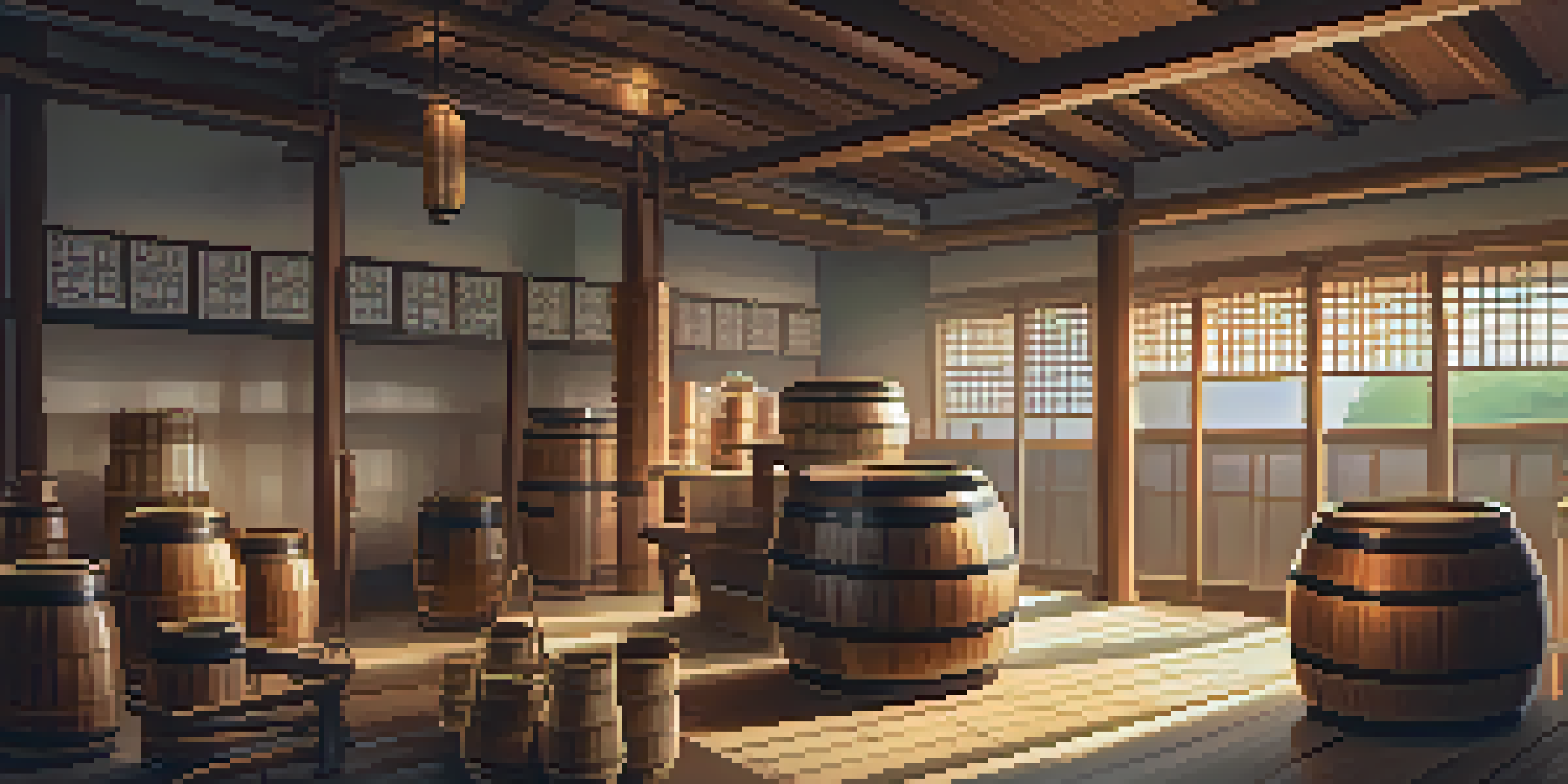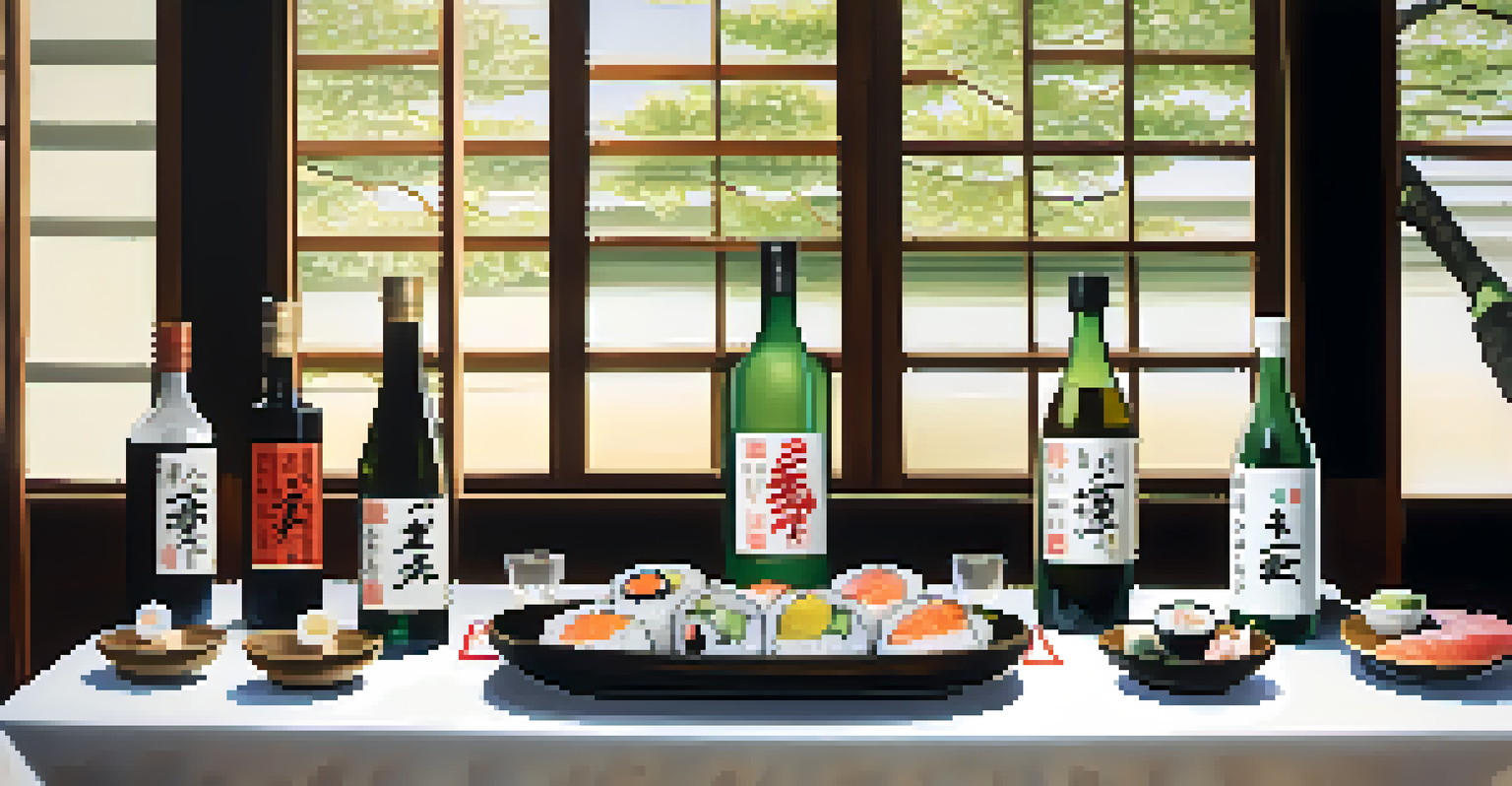Exploring the World of Sake: A Luxury Experience

What is Sake? Understanding This Unique Japanese Beverage
Sake, often referred to as rice wine, is a traditional Japanese alcoholic drink made through a fermentation process that involves rice, water, yeast, and koji mold. Unlike wine, which is fermented from grapes, sake's flavor profile can range from sweet to dry, making it a versatile choice for many occasions. This unique beverage has a rich history, dating back over a thousand years, and is deeply intertwined with Japanese culture and rituals.
Sake is a drink that brings people together, creating connections and memories with each toast.
The process of making sake is intricate and requires precision. It’s essential to use high-quality rice that has been polished to remove the outer layers, which can affect the flavor. This polishing process is measured in a percentage known as the 'seimaibuai,' where a lower number indicates a higher quality sake. Such attention to detail sets the stage for a luxury experience that is both enjoyable and educational.
For newcomers, exploring sake can feel overwhelming, but understanding its basic types—Junmai, Ginjo, and Daiginjo—can simplify your journey. Each type offers a different flavor and aroma profile, which can enhance your tasting experience. As we dive deeper into the world of sake, you'll discover how to appreciate this luxurious beverage fully.
The Art of Sake Brewing: A Craft Like No Other
Brewing sake is often regarded as an art form, where skilled brewers, known as toji, combine their expertise with centuries-old traditions. The brewing process typically takes place in a sake brewery, where each step—from steaming rice to fermentation—is carefully monitored. This meticulous process ensures that each bottle of sake embodies the craftsmanship and dedication invested in its creation.

One of the most fascinating aspects of sake brewing is the koji mold, which converts starches in the rice into sugars, facilitating fermentation. This unique dual fermentation process differentiates sake from other alcoholic beverages and gives it its distinctive taste. The balance between the rice, water, yeast, and koji is crucial, and even slight variations can lead to vastly different flavor profiles.
Sake: More Than Just a Beverage
Sake is deeply intertwined with Japanese culture, serving as a symbol of tradition and community during various ceremonies.
Visiting a sake brewery can be a luxurious experience in itself. Many offer tours that allow you to witness the brewing process firsthand, followed by tastings of various sake types. This immersive experience not only enhances your understanding but also connects you to the rich heritage behind every sip.
Sake Tasting: Elevating Your Palate to New Heights
Tasting sake is an experience that engages all your senses, allowing you to appreciate its complex flavors and aromas. When tasting sake, it's important to serve it at the appropriate temperature, as this can greatly influence its taste. While some varieties are best enjoyed chilled, others may be served warm, enhancing their unique characteristics.
Sake is not just a beverage; it is a reflection of the culture and traditions of Japan, steeped in history and artistry.
As you sip sake, take a moment to observe its color and clarity. A well-crafted sake should be clear, with a slight sheen that reflects light beautifully. Inhale the aroma, allowing the scents to draw you in—notes of fruit, flowers, or even earthy undertones can hint at the sake's profile. When tasting, let the sake linger on your palate to fully appreciate its flavor journey.
Pairing sake with food can elevate your dining experience, as its diverse flavors complement various cuisines. For instance, a crisp Ginjo sake pairs beautifully with sushi, while a richer Junmai can enhance the flavors of grilled meats. Exploring these pairings can open up a world of culinary delight that feels truly luxurious.
Sake and Culture: A Deep-Rooted Connection
Sake is more than just a drink; it’s a symbol of Japanese culture and tradition. It plays a significant role in various ceremonies, from weddings to festivals, and is often used as a way to honor ancestors. This cultural significance adds a layer of depth to every bottle, making it a luxurious experience that transcends taste.
In Japan, sake is often enjoyed during special occasions, and the tradition of 'kanpai'—toasting—brings people together in celebration. This communal aspect of drinking sake fosters a sense of connection and joy, enhancing the overall experience. It’s not just about sipping a beverage; it’s about sharing moments and creating memories.
Crafting Sake: An Intricate Art
The sake brewing process is a meticulous art form that combines high-quality ingredients and centuries-old techniques to create unique flavors.
Moreover, the rituals surrounding sake, such as the custom of pouring for others, reflect the importance of hospitality in Japanese culture. Engaging in these practices during a sake tasting can deepen your appreciation for the drink and the culture it represents, making your journey into the world of sake even more luxurious.
Exploring Different Sake Regions: A Journey of Discoveries
Japan boasts numerous regions known for their distinctive sake, each with its unique climate, water source, and rice varieties. For example, the Niigata region is famous for its clean and crisp sake, while Kyoto is known for its rich and full-bodied brews. Exploring these regions can feel like embarking on a journey, with each stop offering new flavors to discover.
Regional differences play a crucial role in sake production, as the local environment influences the brewing process. The mineral content of the water, the quality of rice, and even the climate can alter the final product significantly. This diversity allows sake enthusiasts to explore a wide range of tastes and styles, making each tasting session a new adventure.
Visiting these sake regions often includes the opportunity to meet local brewers and learn about their unique methods. Many breweries offer tastings and tours, giving you insight into the artistry behind their products. This hands-on experience not only enriches your understanding of sake but also enhances your appreciation for the luxury of this beverage.
Sake Pairings: Elevate Your Dining Experience
Pairing sake with food can transform a meal into a luxurious experience. The key is to understand the flavor profiles of different sake types and how they interact with various cuisines. For example, a light and fruity Junmai Ginjo pairs exquisitely with delicate dishes like sashimi, while a robust Junmai suits heartier flavors like grilled meats.
Exploring sake pairings can be a delightful adventure, as the right combination can enhance both the food and the drink. Consider experimenting with different styles of sake and culinary traditions to discover what resonates with your palate. It’s all about finding that perfect balance, which can elevate your dining experience to a new level.
Sake Pairings Enhance Dining
Pairing sake with food can elevate your dining experience, transforming meals into luxurious culinary adventures.
Many restaurants now offer sake pairings as part of their tasting menus, allowing you to explore this luxurious beverage alongside gourmet dishes. Whether you're dining at a fine restaurant or hosting a dinner party at home, thoughtfully chosen sake can impress your guests and create memorable moments.
The Future of Sake: Trends and Innovations
As the world of sake continues to evolve, new trends and innovations are emerging, making it an exciting time for enthusiasts. Craft sake breweries are popping up globally, experimenting with unique ingredients and brewing techniques. This creativity is expanding the definition of sake and introducing new flavors that appeal to a broader audience.
Moreover, the growing interest in craft cocktails has led to the incorporation of sake into mixology. Bartenders are experimenting with sake-based cocktails, offering a fresh take on traditional drinks. This trend not only broadens the appeal of sake but also showcases its versatility as an ingredient.

With an increasing number of sake festivals and events around the world, the luxury experience of sake is becoming more accessible. As people continue to explore this delightful beverage, the appreciation for its rich history and craftsmanship will undoubtedly grow, leading to even more exciting developments in the future.